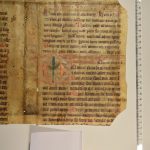The Fragmenta latina codicum (see the Bibliography) only mentions the red staves without notes, in reality faint notes can be discovered at the invitatory. The notes of Ant. Clamor meus had faded away. Matins contains hymn text and square notation.
On the upper part of f. 2v (f. 63v?) part of Ps 104 (Confitemini Domino et invocate) are visible, which in the monastic office fitted into the Saturday Matins. It was sung in division, as indicated by the „Divisio” rubric before the verse „Et intravit Israel…”. The invitatory antiphon and the melody of the first psalm written on the recto of f. 1 (f. 60r) is essentially identical with the melodies in a 15th century Benedictine psalter and antiphonal from Augsburg (Psalterium OSB, Augsburg, Mon. St. Ulrich & Afra, 1494, f. 87v, München, Bayerische Staatsbibliothek, Clm. 4301; Antiphonale OSB, Augsburg, Mon. St. Ulrich & Afra, 1494, f. 137r; München, Bayerische Staatsbibliothek, Clm. 4303, cf. http://cantus.uwaterloo.ca/source/123681). But, the Cistercians, for example used different melodic variants and another hymn (Aeterne Rex) at this point of the Office (Psalterium OCist, impr. 1533). The Benedictine origin is probable.
Gabriella Gilányi, Gábriel Szoliva


